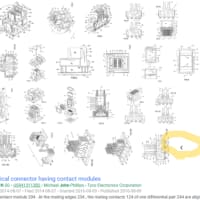「基板の端部」と言う場合、an endかthe endか迷います。
「第1の端部」なら迷うことなく初出は不定冠詞。
しかし単なる「端部」。「どことは限定するまでもない、具体的な話がしたいんじゃない、とにかく端っこの部分という概念」のような感じの場合ってことでいいんでしょうか?
どういう場合にいきなりthe endを使えるのか?
WO2011133386(既出)
[0031] FIG. 2 is a partial perspective view of a polishing station 124 having a conditioning module 132 according to embodiments described herein. Each conditioning module 132 includes a pad conditioning assembly 140. In one embodiment, the pad conditioning assembly 140 comprises a conditioning head 242 supported by a support assembly 246 with a conditioning arm 244 therebetween. In one embodiment, the pad conditioning assembly 140 further comprises a displacement sensor 260 coupled with the conditioning arm 244. In another embodiment, the displacement sensor 260 may be coupled with the conditioning head 242.
[0032] The support assembly 246 is adapted to position the conditioning head 242 in contact with the polishing surface 130, and further is adapted to provide a relative motion therebetween. The conditioning arm 244 has a distal end coupled to the conditioning head 242 and a proximal end coupled to the base 247. The base247 rotates to sweep the conditioning head 242 across the polishing surface 130 to condition the polishing surface 130. As a result of the relative motion of the conditioning head 242 with respect to the polishing surface 130 of the polishing pad 200, the displacement sensor 260 takes thickness measurements of the polishing surface 130 and the polishing pad 200.
[0033] The sensor coupled to the conditioning arm allows a thickness of the polishing pad 200 to be measured at various points during a portion of a normal operation cycle, while the accompanying logic allows the measurement data to be captured and displayed. In some embodiments, the displacement sensor 260 may utilize an inductive sensor.
[0034] In embodiments where the displacement sensor 260 is a laser based sensor, the thickness of the polishing pad 200 is measured directly. The conditioning arm 244 is in a fixed position with respect to the platen 240, and the laser is in a fixed position with respect to the arm. Consequently, the laser is in a fixed position with respect to the platen assembly 240. By measuring the distance to the processing pad and calculating the difference between the distance to the polishing pad 200 and the distance to the platen assembly 240, the remaining thickness of the polishing pad 200 may be determined. In some embodiments, the resolution of the thickness measurement using the laser based displacement sensor 260 may be within 25um.
[0035] In embodiments where the displacement sensor 260 is an inductive sensor, the thickness of the polishing pad 200 is measured indirectly.
【0026】
変位センサ260が誘導性センサである実施形態では、研磨パッド200の厚さは間接的に測定される。
The conditioning arm 244 is actuated around a pivot point until the conditioning head 242 comes in contact with the processing pad 200.
調整アーム244は、調整ヘッド242が処理パッド200に接触するまで、枢動点の周りで作動される。
An inductive sensor, which emits an electromagnetic field, is mounted to the end(*定冠詞;distal or proximal?)of the pivot based conditioning arm 244.
枢動ベースの調整アーム244の端部には、電磁界を放出する誘導性センサが取り付けられる。

In accordance with Faraday's law of induction, the voltage in a closed loop is directly proportional to the change in the magnetic field per change in time. The stronger the applied magnetic field, the greater the eddy currents developed and the greater the opposing field. A signal from the sensor is directly related to thedistance from the tip of the sensor to the metallic platen assembly 240. As the platen assembly 240 rotates, the conditioning head 242 rides on the surface of the pad and the inductive sensor rises and falls with the conditioning arm 244 according to the profile of the polishing pad 200. As the inductive sensor gets closer to the metallic platen assembly 240, an indication of processing pad wear, the voltage of the signal increases. The signal from the sensor is processed and captures the variation in the thickness of the polishing pad assembly 200. In some embodiments, the resolution of the thickness measurement using the inductive sensor 260 may be within 1 um.
*数パラグラフ全体を読んでようやくthe endの位置(arm 244のhead 242側)が分かると思う。
US8316518(既出)
可撓性回路から支持体を介してPZTスタックに接続。
[0102] Referring now to FIGS. 11A and 11B, in one aspect, the bottom surface of the piezoelectric layer can be lapped to a desired thickness prior to the formation of the first and second kerf slots 818 , 822 , respectively. The first and second kerf slots are formed to the desired depth in the stack. The first and second kerf slots are machined in the stack from the bottom side of the stack. In one aspect, the first and second kerf slots are laser machined into the stack using a laser fluence of about and between 3-10 J/cm2 and preferably about 5 J/cm2 . This laser fluence is adequate to create the kerf aspect ratios that are desired in the piezoelectric layer of the stack.
[0125] In an additional step and referring to FIGS. 22A and 22B, the signal return path from the stack to the coupled flex circuits should be operably coupled prior to the formation of the signal electrodes. This allows for the electrical integrity of the signal electrode to be tested after the signal electrode pattern has been created. In one aspect a conductive material, such as, copper tape 915 and the like, is positioned on the array assembly to electrically couple the respective first and second ground electrodes to the respective grounds 920 on the flex circuits.
The copper tape can be bonded with additional conductive epoxy material or low temperature solder to form a reliable electrical contact.
銅テープは、信頼性のある電気接点を形成するために、付加的な導電性エポキシ材料または低温はんだで接合することができる。
Thus, in one example, the signal return path from the assembly
したがって、アセンブリからのリターン経路は、
extends generally parallel to the kerfs to the end of the stack, up through the conductive epoxy bond line into the copper foil
切り溝に概して平行に積層体の端部まで、導電性エポキシ接合線を通って上に向かって銅箔の中に入り、
and then onto the flex circuit via the additional conductive path of the exemplary copper tape.
次いで、例示的な銅テープの付加的な導電性経路を介して、可撓性回路上に延在する。



(線がkerfs)
*よく分からないがとにかく「一端」や「他端」の問題ではなく、「端部」。
WO2015103493(既出)
[00084] FIG. 9B depicts one such embodiment of a pendulum screen shaker 902 comprising such a counterweight.
【0075】
図9Bは、このような釣合錘を有する振り子スクリーンシェーカ902のこのような一実施形態を示している。
As seen, shaker 902 comprises voicecoil 104 (e.g. without any added weight) and positioned below the pivot (e.g. distal from the pivot).
図示されるように、シェーカ902は、回動軸の下方において(例えば、回動軸から遠い位置において)位置決めされた(例えば、追加の錘を有していない)ボイスコイル104を有する。
An adjustment weight 906 is attached at the end of arm 904 at or near the pivot of the pendulum.
調節錘906が、振り子の回動軸又はその近傍において、アーム904の端部に装着されている。

*図を見れば分かるから?


























※コメント投稿者のブログIDはブログ作成者のみに通知されます